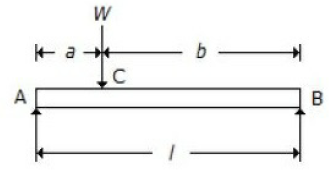In order to prevent crushing of masonry at the base of the dam, the maximum stress should be __________ the permissible stress of the soil.
Equal to
Less than
More than
None of these
Correct Answer :
B. Less than
Related Questions
Which of the following has the minimum atomic mass?
Oxygen
Sulphur
Nitrogen
Carbon
Shear stress induced in a shaft subjected to tension will be
Maximum at periphery and zero at center
Maximum at center
Uniform throughout
None of the above
For a beam, as shown in the below figure, the deflection at C is (where E = Young's modulus for the beam material, and I = Moment of inertia of the beam section.

Wl3/48 EI
Wa²b²/3EIl
[Wa/(a√3) x EIl] x (l² - a²)3/2
5Wl3/384 EI
Two shafts 'A' and 'B' transmit the same power. The speed of shaft 'A' is 250 r.p.m. and that of shaft 'B' is 300 r.p.m.
The shaft 'B' has the greater diameter
The shaft 'A' has the greater diameter
Both are of same diameter
None of these
The property of a working substance which increases or decreases as the heat is supplied or removed in a reversible manner, is known as
Enthalpy
Internal energy
Entropy
External energy
A concentrated load is one which
Acts at a point on a beam
Spreads non-uniformly over the whole length of a beam
Spreads uniformly over the whole length of a beam
Varies uniformly over the whole length of a beam
Which of the following is correct?
Gauge pressure = Absolute pressure + Atmospheric pressure
Absolute pressure = Gauge pressure + Atmospheric pressure
Absolute pressure = Gauge pressure - Atmospheric pressure
Atmospheric pressure = Absolute pressure + Gauge pressure
Which of the following is the correct statement?
For a given compression ratio, both Otto and Diesel cycles have the same efficiency.
For a given compression ratio, Otto cycle is more efficient than Diesel cycle.
For a given compression ratio, Diesel cycle is more efficient than Otto cycle.
The efficiency of Otto or Diesel cycle has nothing to do with compression ratio.
The ideal efficiency of a Brayton cycle with regeneration, with increase in pressure ratio will
Increase
Decrease
Remain unchanged
Increase/decrease depending on application
The oxygen atom is ________ times heavier than the hydrogen atom.
2
8
16
32
The compression ratio is the ratio of
Swept volume to total volume
Total volume to swept volume
Swept volume to clearance volume
Total volume to clearance volume
A bar of copper and steel form a composite system, which is heated to a temperature of 40°C. The stress induced in the copper bar will be
Tensile
Compressive
Shear
Zero
When a gas is heated at constant pressure
Its temperature will increase
Its volume will increase
Both temperature and volume will increase
Neither temperature not volume will increase
The neutral axis of a transverse section of a beam passes through the centre of gravity of the section and is
In the vertical plane
In the horizontal plane
In the same plane in which the beam bends
At right angle to the plane in which the beam bends
The ratio of direct stress to volumetric strain in case of a body subjected to three mutually perpendicular stresses of equal intensity, is equal to
Young's modulus
Bulk modulus
Modulus of rigidity
Modulus of elasticity
Stirling and Ericsson cycles are
Reversible cycles
Irreversible cycles
Semi-reversible cycles
Adiabatic irreversible cycles
The value of cp/cv for air is
1
1.4
1.45
2.3
Which of the following statement is correct?
The stress is the pressure per unit area
The strain is expressed in mm
Hook's law holds good upto the breaking point
Stress is directly proportional to strain within elastic limit
When a body is subjected to a direct tensile stress (σ) in one plane, then maximum normal stress occurs at a section inclined at __________ to the normal of the section.
0°
30°
45°
90°
The change of entropy, when heat is absorbed by the gas, is
Positive
Negative
Positive or negative
None of these
The hyperbolic process is governed by
Boyle's law
Charles' law
Gay-Lussac law
Avogadro's law
A cantilever beam is one which is
Fixed at both ends
Fixed at one end and free at the other end
Supported at its ends
Supported on more than two supports
The point of contra flexure is a point where
Shear force changes sign
Shear force is maximum
Bending moment changes sign
Bending moment is maximum
Which of the following gas is mostly used in town for street and domestic lighting and heating?
Producer gas
Coal gas
Mond gas
Coke oven gas
The stress induced in a body due to suddenly applied load compared to when it is applied gradually is
Same
Half
Two times
Four times
Steam coal is a
Pulverised coal
Brown coal
Coking bituminous coal
Non-coking bituminous coal
When a body is subjected to a direct tensile stress (σx) in one plane accompanied by a simple shear stress (τxy), the maximum shear stress is
(σx/2) + (1/2) × √(σx² + 4 τ²xy)
(σx/2) - (1/2) × √(σx² + 4 τ²xy)
(σx/2) + (1/2) × √(σx² - 4 τ²xy)
(1/2) × √(σx² + 4 τ²xy)
The cycle in which heat is supplied at constant volume and rejected at constant pressure is known as
Dual combustion cycle
Diesel cycle
Atkinson cycle
Rankine cycle
Which of the following is the correct statement of the second law of thermodynamics?
It is impossible to construct an engine working on a cyclic process, whose sole purpose is to convert heat energy into work.
It is impossible to transfer heat from a body at a lower temperature to a higher temperature, without the aid of an external source.
There is a definite amount of mechanical energy, which can be obtained from a given quantity of heat energy.
All of the above
The fuel mostly used in steam boilers is
Brown coal
Peat
Coking bituminous coal
Non-coking bituminous coal
